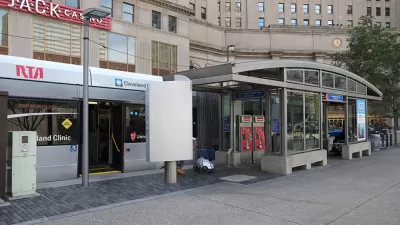Cleveland's bus rapid transit system, called the HealthLine, only opened in 2008, but it has already shown signs of "stimulating economic growth significantly" along Euclid Avenue.
Named the HealthLine by the Cleveland Clinic and the University Hospitals of Cleveland, the $200 million bus rapid transit system along Euclid Avenue has connected "Cleveland's top economic generators": downtown and University Circle. The fact that the HealthLine links the two commercial hubs is not the only reason why the project was recognized with an Urban Land Institute Award for Excellence in 2011; it has "generated the economic growth that many thought could only be achieved with rail--and at a fraction of the cost."
Part of the strategy to stimulate that growth was to design the bus system as if it were a rail line. This meant raised platforms on medians for level boarding, bus-only lanes, and fare collection outside of the bus. The stations themselves were designed by Robert P. Madison International Inc. to be prominent structures of glass and steel instead of the typical small sign on a street corner.
Even though there are fewer stops, the 24/7 schedule makes the HealthLine a reliable method of transportation, and ridership has grown to 15,100 people per day. Jason Hellendrung reports that the placement of the line in the middle of the street has opened up parking spaces along the sidewalk, helping streetfront businesses. Other encouraging results include the influx of companies along the formerly "downtrodden" parts of Euclid Avenue.
Since the bus project opened relatively recently, in 2008, the economic activity has been a welcome surprise. Michael Schipper, a Regional Transit Authority general manager, acknowledged that "We wouldn't have expected this type of thing until five or so years out."
FULL STORY: HealthLine Drives Growth in Cleveland

Alabama: Trump Terminates Settlements for Black Communities Harmed By Raw Sewage
Trump deemed the landmark civil rights agreement “illegal DEI and environmental justice policy.”

Study: Maui’s Plan to Convert Vacation Rentals to Long-Term Housing Could Cause Nearly $1 Billion Economic Loss
The plan would reduce visitor accommodation by 25% resulting in 1,900 jobs lost.

Planetizen Federal Action Tracker
A weekly monitor of how Trump’s orders and actions are impacting planners and planning in America.

Wind Energy on the Rise Despite Federal Policy Reversal
The Trump administration is revoking federal support for renewable energy, but demand for new projects continues unabated.

Passengers Flock to Caltrain After Electrification
The new electric trains are running faster and more reliably, leading to strong ridership growth on the Bay Area rail system.

Texas Churches Rally Behind ‘Yes in God’s Back Yard’ Legislation
Religious leaders want the state to reduce zoning regulations to streamline leasing church-owned land to housing developers.
Urban Design for Planners 1: Software Tools
This six-course series explores essential urban design concepts using open source software and equips planners with the tools they need to participate fully in the urban design process.
Planning for Universal Design
Learn the tools for implementing Universal Design in planning regulations.
Caltrans
Smith Gee Studio
Institute for Housing and Urban Development Studies (IHS)
City of Grandview
Harvard GSD Executive Education
Toledo-Lucas County Plan Commissions
Salt Lake City
NYU Wagner Graduate School of Public Service



























